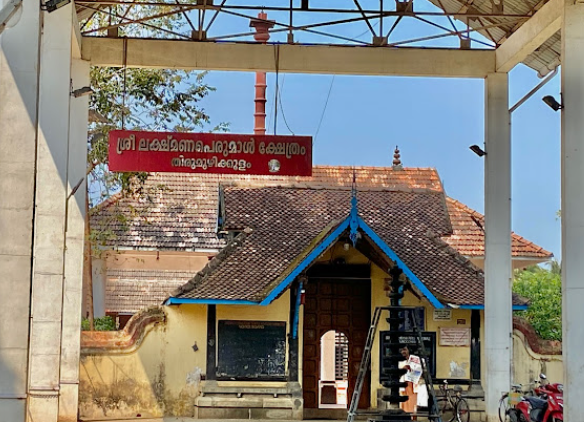Mulakkulam Sree Lakshmana Swamy Temple, located in Thirumoozhikkulam (Moozhikulam) in the Ernakulam district of Kerala, holds significant importance in Hindu mythology and history. Mentioned in ancient Tamil scriptures such as the Nalayira Divya Prabandham, sung by Sri Vaishnava Alvars like Nammalvar and Tirumangai Alvar, it is recognized as one of the 108 Divya Desams, which are highly revered in Vaishnavism. This temple is particularly notable as one of the 13 Malai Naatu (Kerala/Chera) Divya Desams.
According to legend, this temple is the sacred site where Lakshmana, the brother of Lord Rama, worshipped alongside their other brother, Bharata. The presiding deity is Lakshmana, enshrined in the temple in a Kerala-style architectural setting, surrounded by granite walls. The temple is also one of the four that are integral to the Nalambalam Yatra, a pilgrimage that includes Rama at Thriprayar, Bharata at Irinjalakuda, Lakshmana at Moozhikulam, and Shathrughna at Payammal.
The temple has been built and maintained over centuries, with contributions from various ruling empires, showcasing exquisite Kerala architecture. It is managed by the Travancore Devaswom Board of the Government of Kerala and is open daily from 5:00 AM to 11:00 AM and from 5:00 PM to 8:00 PM.
Adding to its cultural significance, the temple also preserves and practises the traditional dance form of Kutiyattam, making it a vital centre of spiritual and cultural heritage in Kerala.
Puranic Significance :
According to legend, when Lord Krishna resided in Dwarka, he worshipped four idols representing Raman, Lakshmanan, Bharathan, and Shatrughan. After Dwarka was submerged, these idols were discovered by the sage Vakel Kaimal. That night, the Lord appeared in the sage's dream and instructed him to dedicate the idols on the banks of the Bharathapuzha River. These idols are now enshrined in the Thirupparaiyar Ram Temple in Thrissur district, the Bharathan Temple in Irinjalakuda, the Shatrugan Temple in Payammal, and the Lakshmana Perumal Temple in Thirumoozhikkulam, Ernakulam district. Thirumoozhikkulam is the only temple in Kerala where Lakshmana is honoured with the title of Lakshmana Perumal.
Another significant legend tells of Haritha Maharishi, who performed penance at this sacred site. Pleased with his meditation, Perumal (the deity) appeared before the sage and offered to grant him a boon. The Maharishi requested a simple path for all people to reach the Lord. Perumal responded by bestowing upon him the "Sri Sukti," a sacred text that outlines the rules of worship and the principles of Varnasrama Dharma, which guide people in their spiritual journey based on their duties and professions. This is why the place is known as Thirumozhikkalam, and the deity as Thirumozhikkalam Perumal. Over time, this became a significant aspect of the temple's rituals.
